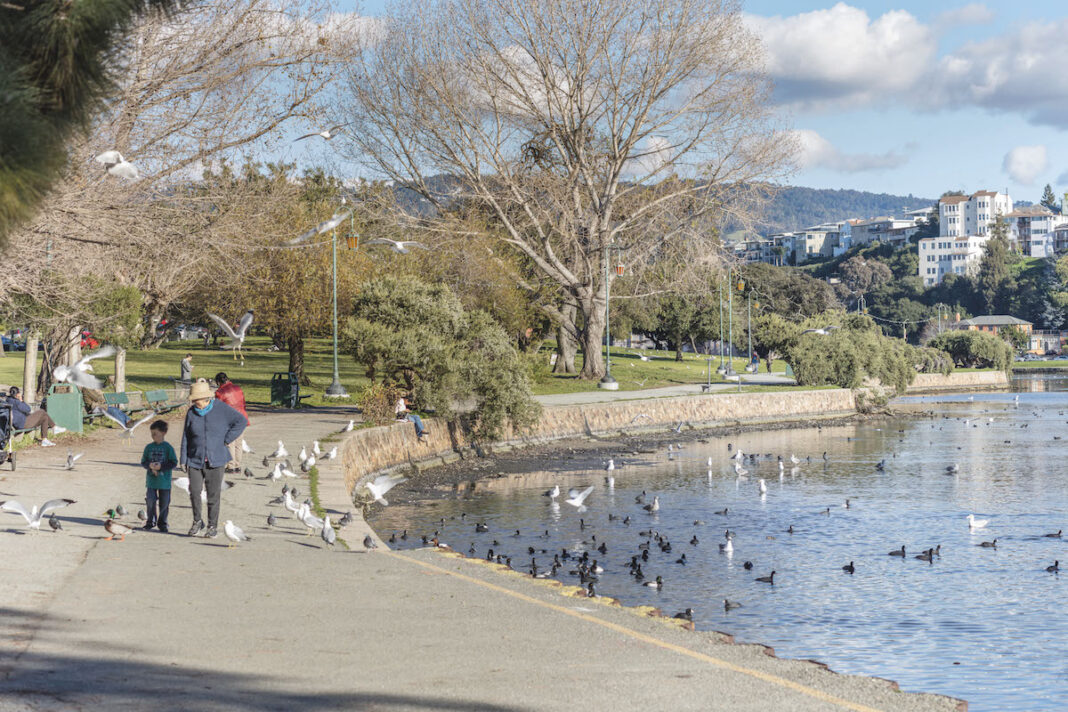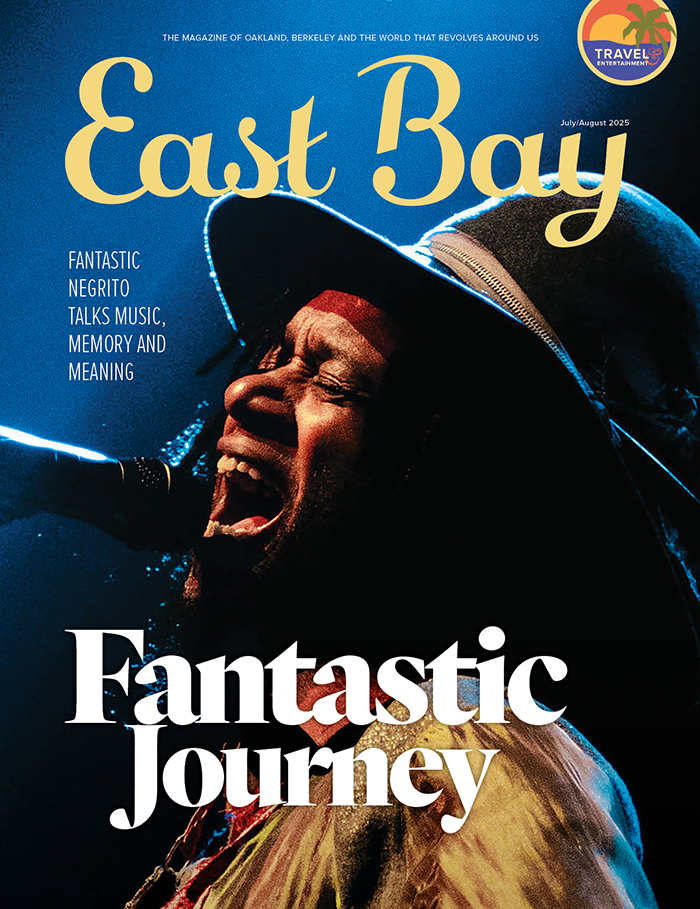Local residents and frequent visitors to Lake Merritt might think they know everything about what has long been considered a “crown jewel” of Oakland. But much like an image appearing in a mirror held up to the city in which it is a centerpiece, the lake that is actually a lagoon and harbors the nation’s first wildlife refuge reflects a layered, complex, intriguing history.
An especially complicated and precarious profile appears during contemporary times as energy leans into building and housing developments and urban green spaces are increasingly at risk. Casting its wave into the future, aspirations for Lake Merritt are swept up and tossed by topical issues relevant to nature preservation in cities: the impacts of climate change on flooding, toxic stormwater runoffs, civic fiscal precarity and tight budgets during economic downturns, and lack of public awareness and knowledge regarding conservation.
Other issues include, realistically, crime, homelessness, wanton disregard or ignorance about the Earth’s precious, dwindling natural resources, and broad-based misunderstandings about science and the interdependency of the ecosystem that connects human welfare to that of wildlife, plants, trees, soil, water and other elements found in green areas of urban landscapes.
Oakland Council President Nikki Fortunato Bas has been a resident of District 2, where Lake Merritt is located, for more than two decades. Bas emphasized in an interview the lake’s future revolves around preserving its ecology, all-hands-on-deck community involvement, and fostering an environment that is inclusive, accessible and equitable. “We need everyone who visits to be involved: neighbors, visitors, city staff and people connected with places working on the frontline, like the Lake Merritt Institute,” she said.
The Lake Merritt Institute, founded in 1992 by Dr. Richard Bailey, is a nonprofit corporation that works to keep clean and educate people about the lake. With a workforce of volunteer laborers, a board of directors and a small staff led by executive director James Robinson, the organization plays a critical role in preserving the lake’s water quality, protecting the wildlife and communicating the cultural importance of Lake Merritt to the public.
“We rely on organizations like the Lake Merritt Institute and the media and through our City of Oakland programs to let people know about the lake issues,” said Bas. “We always have to work hard and will continue to work to get the city to post more signs that help people recognize it’s a wildlife refuge. But there are also sensitive aspects of how to treat it and take care of it, so through the Parks and Recreation Department and with the new (Mayor-elect Sheng Thao) coming in, I’m hoping the outreach will increase. I’ve heard her speak about the importance of outdoor spaces, and I plan to speak with her about all of our city parks, not just Lake Merritt.”
While championing recent improvements and upgrades such as the twice-a-day restroom cleaning (up from once-a-day), the newly renovated Pergola, shoreline reinforcements, and painting and repairs to fences, signs and walkways throughout the park, Bas was most enthused about an initiative launched in the summer of 2022.
“I funded a pilot program of park stewards who are out at the lake educating users about permitting, litter container locations, noise and safety regulations and practices,” she said. “The program was started with mid-cycle city budget funds in June and began in July. If it goes well, it will continue, and I expect that to happen.”
Bas said the park stewards are predominantly people from Oakland who know the community well. “All of the stewards went through interviews and a long hiring process to make sure they have high-level interpersonal skills. Also, they’re trained in de-escalation tactics, so they’re good at dealing with the public and any issues that come up.”
Lake Merritt’s 3.4 mile circumference occupies roughly 155 acres of land. Composed of a mix of freshwater and saltwater, the depth varies and depends on water flowing in from tidal estuaries and the amount of rainfall. The five-piece archipelago of islands that house an unusual avian assortment with dozens of species of birds was sculpted more than 100 years ago from leftover construction dirt. As the City of Oakland grew rapidly in the early 1800s, the lagoon that sits on what was originally Ohlone land was colonized; the land desecrated and the lake turned into an odiferous, sewage dump.
A cleanup driven more by commerce than environmentalism was begun in 1869 by Samuel Merritt, a wealthy physician and the city’s 13th mayor. He hoped to hide the stench, considered a deterrent to developers, and in 1870, Lake Merritt became the nation’s first wildlife refuge. Sewer pipes were redirected so wastewater went to water treatment plants, and in 1985, the lake was dredged to remove polluted sediment. In 2006, the city invested $1 million, making improvements by stabilizing lake edges, expunging invasive plant species, installing a new irrigation system, and adding living trees and foliage.
More recently, trash visible on the lake sparked a response that led to “Adopt a Storm Drain”and “We Mean Clean,” county programs to support a cleaner watershed and estuary. Funds from Measure DD were directed to water quality improvements, increased bike and pedestrian access, wetland restoration and other measures. Discussions between the city and Alameda County about additional improvements continue in 2023.
The Lake Merritt Institute’s Robinson recalled in a separate interview his introduction to Lake Merritt. “I was raised and went to school in Oakland and for years, I never went near it. When I was young, most people thought it was a landfill, and people talked about dead people being found in it. It wasn’t until high school that I started to visit. It was Dr. Bailey who told me about the wildlife and about the difference between a storm drain and a sewer,” he recalled.
Robinson remembers feeling surprised when he learned from Bailey that the city’s sewers deliver water entirely to water treatment centers and only storm drains connect directly into nearby bodies of water. Lake Merritt has more than 63 storm drains.
“I was fascinated that the majority of trash you see and toxins in the lake came from storm drains,” he said. “Trash and lawn pesticides and refuse from roofs, yards and gardens wash in from surrounding neighborhoods and come into the lake when it rains. Why did that interest me? I suppose because I used to watch Ninja Turtles and I thought they lived in sewers—that’s what they always said on the show—but they actually lived in a storm drain. It caught my attention when I learned about it from Dr. Bailey and then watching the show, I realized the differences.”
Soon, Robinson was kayaking around the lake, enjoying the birds and wildlife, finding a vested interest in preserving it. “I had a genuine connection. It was all about people relating to people. Being out on the lake, with access to water, I found out all the rumors were for the most part false. It was an amazing experience. It’s important to build that connection and then, when you care about it, no one needs to prod you to go out and make sure it’s doing alright.”
Robinson said he’d love to see the endless empty chip bags, water bottles, food wrappers, plastic containers and cigarette butts eliminated. “We see the birds eating the trash, which is so disturbing. If people want to help, volunteering to clean up and calling local city leaders to advocate for a tax on plastics or a ban on containers are two steps that will have immediate impacts. When styrofoam takeout containers were banned, data showed a significant decrease in that form of trash in the lake.”
During the pandemic, and especially after disinformation spread on mainstream and social media concerning a common summer algae bloom that caused the water to turn brackish and a fish die-off, Robinson said public interest in the lake’s purity spiked. “People emailed, called with concern for about a month. People wanted to help, to make donations,” he recalled. “We went from 20 emails a day to 100, and from five calls on average daily to 50 calls a day.”
After the fervor died down, Robinson said public attention returned to the city’s perennial and persistent preoccupations: homelessness, crime, social injustice, gun violence, inequities in commerce and education and more. The institute’s usual need for more volunteers resumed and continues, especially during the rainy season when inclement weather means less people are willing to join in to pick up trash or pull invasive weeds.
Asked about the impact of the pandemic on Lake Merritt and the public’s relationship with outdoor spaces and recreation, Bas said, “We’ve been many years living with COVID, and the reality is that COVID continues. That means outdoor spaces continue to be critical. In addition to Lake Merritt, it’s all the local parks we need to protect.
“I also have San Antonio Park in my district. It is well programmed with things like the Malcolm X Jazz Festival, community food distribution days and lots of recreational programming. We have to make sure people activate neighborhood parks in addition to Lake Merritt. If we have proper capacity and activity at those parks, it will help the lake because it will reduce the chance of overpopulating the one location.”
“The heart of preserving Lake Merritt is giving people reasons to care,” said Robinson. “Lake Merritt indicates the community’s greater health. It’s true connection that matters, and once that’s established in someone, it won’t ever die.”
For more information, visit lakemerrittinstitute.org or oaklandca.gov.











